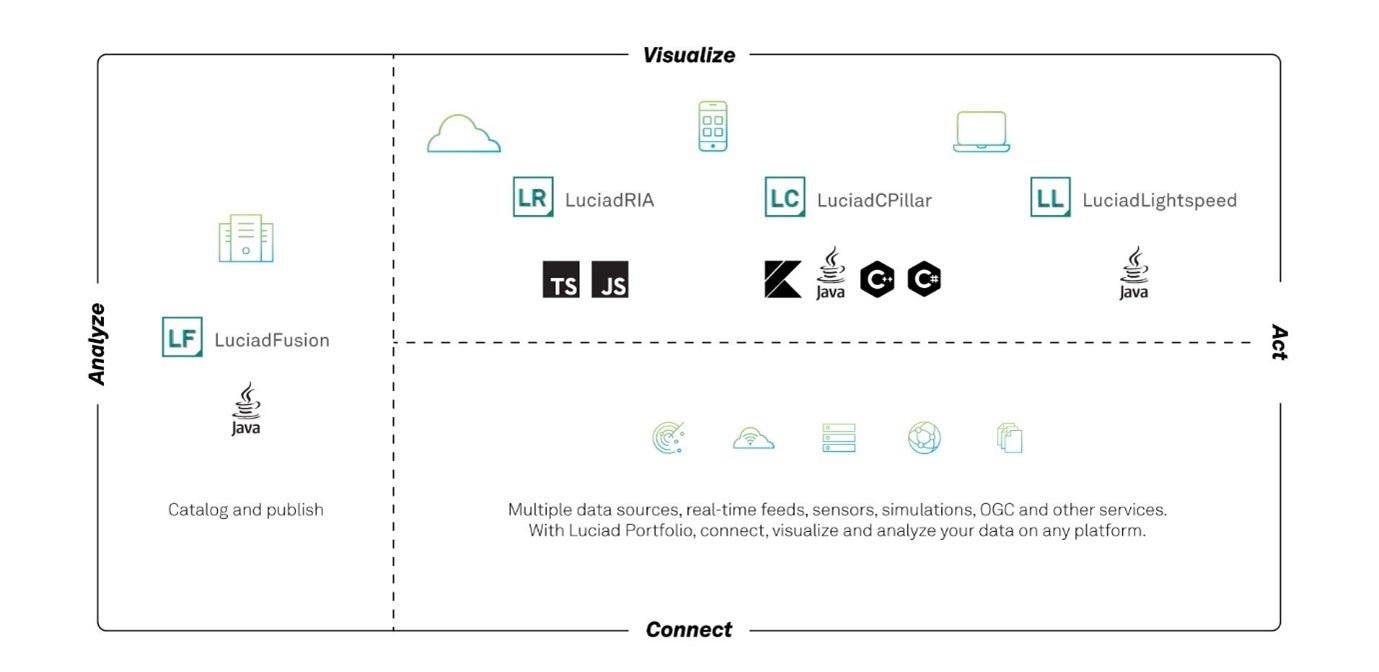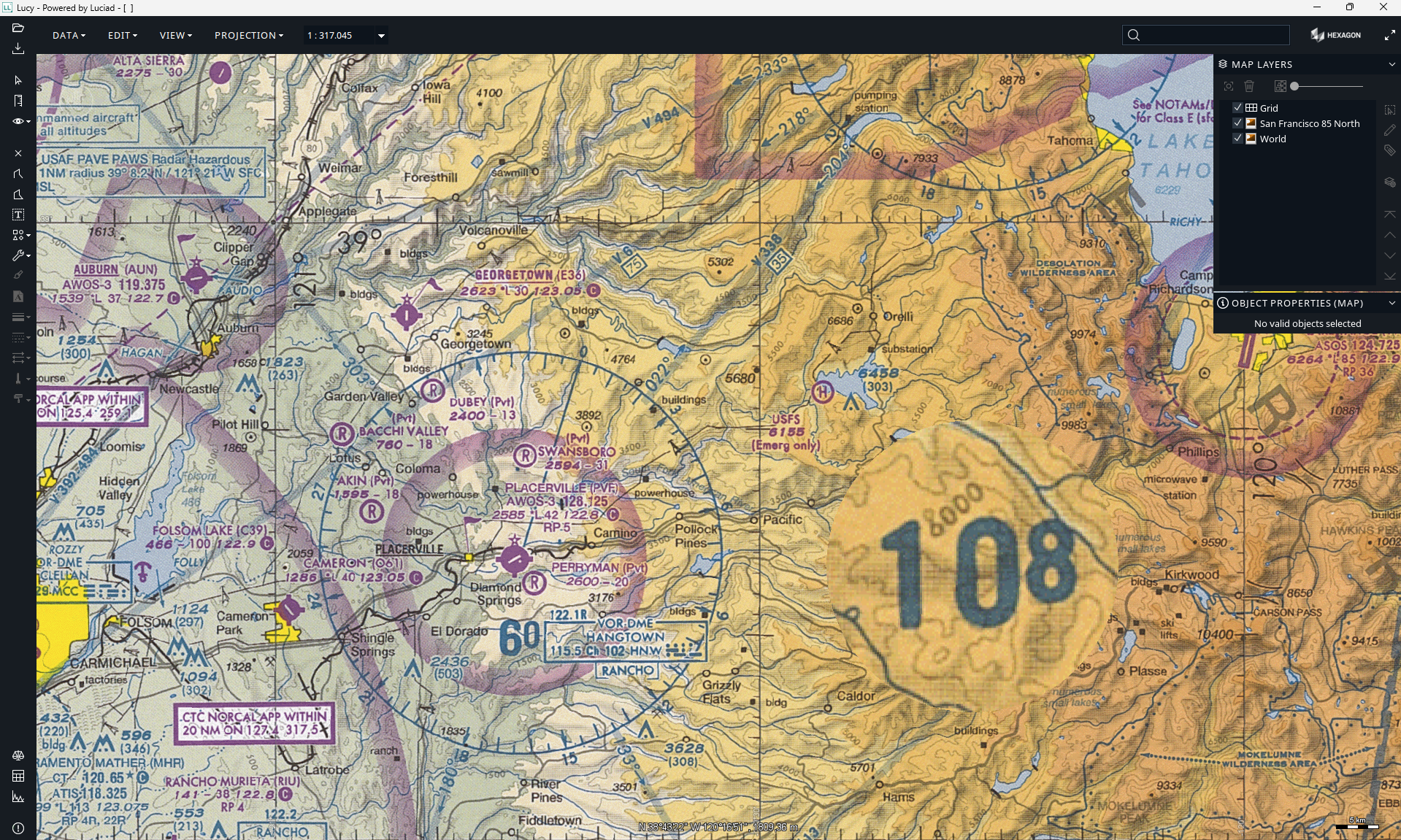About this release
The 2025.0 release of LuciadLightspeed brings visualization of CAD data to the Lightspeed view and Lucy, upgrades the NITF support, and makes sure you can migrate from Bing Maps to Azure Maps.
This document lists the most noteworthy improvements. You can find the full list of changes in the release notes.

Benefits of the new features
An update to the LuciadLightspeed NITF support
For this release of LuciadLightspeed, we dusted off our NITF decoder. NITF decoding support is a long-standing feature of our product. We acted on collected feedback and improved the handling of images and vector overlays. These improvements also led to the introduction of a new third-party library to decode JPEG images, libjpeg-turbo, and the removal of a class and some methods from the API because they were never intended for direct use and caused some confusion.
The NITF decoder now also supports a new use case: use of NITF information in a non-georeferenced view. In a non-georeferenced view, you can display the images in pixel coordinates instead of draping them on the map, which could cause some warping.
With this aim, TLcdNITFModelDecoder.discoverDataSources now offers two data sources.
You can use the first data source to decode the NITF data into a georeferenced model, similar to the data source returned in the past. With the resulting model, you can visualize the data in a georeferenced GXY or Lightspeed view. The data will be brought to the map and converted to the view reference. This conversion may cause the images to be draped or warped. The benefit of this approach is that it shows the data in context, combined with other data you may have of the same area.
You can use the second data source to decode the NITF data into a non-georeferenced model. With the resulting model, you can
visualize the data in a GXY view with a CRS:1 reference. The GXY view will display the image in pixel coordinates, which allows
for a fine-grained inspection of all its annotations. To this end, this non-georeferenced model is an ILcdModelTreeNode with a sub-model for each NITF data segment.
Sample code/documentation to get you started
We refer to the existing NITF documentation for more information on how to integrate this format: Data Formats: NITF/NSIF. For details about the new third-party library and slight API modifications, see the release notes.
Integrate and visualize Microsoft Azure Maps
The Microsoft Azure Maps service offers map data such as high-resolution imagery and roadmaps. You can now connect to the Azure Maps service, integrate the Azure Maps data of your choosing as a LuciadLightspeed model, and visualize it as a layer in your Lightspeed and GXY views.

The LuciadLightspeed API also provides the necessary tools to show the required logo and copyright notices.
|
Azure Maps is a good alternative for users of the Bing Maps service. Microsoft is gradually retiring its Bing Maps service. If you’re a Bing Maps user with a free account, you won’t be able to use Bing Maps data anymore after June 30th, 2025. Enterprise account users will still have access to Bing Maps services until June 30th, 2028. |
You can load and visualize Azure Maps through the Lucy application framework too, as illustrated in this figure.
Sample code/documentation to get you started
To quickly get Azure Maps data on your map, see Data Formats: Azure Maps.
To learn more about working with Azure Maps layers in Lucy, see the Azure Maps section in the Lucy user’s guide.
Visualize DWG and DGN charts on a Lightspeed view
GeoBIM, the integration of Geographic Information Systems (GIS) and Building Information Modeling (BIM), is gaining traction.
This trend has translated into a renewed interest for integrating CAD data. LuciadLightspeed already offered the capability
to decode the formats Microstation DGN and Autocad DWG in its early days. Until now, the visualization was limited to the
GXY view only. This release brings support for the visualization of these formats in the Lightspeed view. You will find new
stylers and layer factories for this in the API: TLspDWGStyler, TLspDWGLayerFactory, TLspDGNStyler and TLspDGNLayerFactory.
Lucy now also supports the DWG and DGN file formats natively in Lightspeed views, including their styling. Two new add-ons enable this capability:
-
TLcyLspDWGFormatAddOnto load DWG and DXF files on a Lightspeed view -
TLcyLspDGNFormatAddOnto load DGN files on a Lightspeed view
Note that the DWG format add-on does not support splitting the models into multiple layers yet.
Sample code/documentation to get you started
To help you visualize CAD data on your Lightspeed view, the product documentation set includes two new tutorials, one for each format. See Data Formats: AutoCAD DWG and DXF and Data Formats: Microstation DGN.
Support for OGC 3D Tiles 1.1
As an upgrade to the existing OGC 3D Tiles support, this release of LuciadLightspeed brings support for data encoded according to the 3D Tiles 1.1 specification.
You can find out the version of the decoded 3D Tiles data through the type name of the model descriptor. This will be "3D Tiles" for a 3D Tiles 1.0 dataset, and "3D Tiles 1.1" for a 3D Tiles 1.1 dataset.
For both versions, LuciadLightspeed decodes the tileset.json with full metadata support, including property values and ranges. The main difference between the versions resides in the
payload. For OCG 3D Tiles, the payload is the Batched 3D Model (B3DM) tile format, with glTF 1.0 and glTF 2.0 for meshes and
the Point Cloud (PNTS) tile format for point clouds. In the case of OGC 3D Tiles 1.1, the payload is the glTF 2.0 tile format.
The decoder for 3D tiles 1.1 datasets also supports implicit tiling and these glTF extensions:
-
EXT_mesh_gpu_instancing
-
EXT_meshopt_compression
-
KHR_binary_glTF
-
KHR_draco_mesh_compression
-
KHR_mesh_quantization
-
KHR_texture_transform
Finally, the Lucy addon TLcyLsp3DTilesFormatAddon replaces the deprecated TLcyLsp3DTilesB3DMFormatAddon and TLcyLsp3DTilesPNTSFormatAddon addons.
Sample code/documentation to get you started
All relevant articles within the section Data Formats: OGC 3D tiles have been updated to reflect this upgrade.
Other improvements
- Updated platform requirements
-
In alignment with the end of support for Windows 8.1 and Windows Server 2012 by Microsoft, and the end of support for macOS 12 by Apple, we are updating our platform support. LuciadLightspeed is now supported for development and deployment on:
-
Windows, starting from Windows 10 and Windows Server 2016
-
macOS, starting from macOS 13
-
- Circular shape for magnifier controller
-
You can use the magnifier controller to zoom in on a part of the map using the mouse. A new
TLspMagnifierControllerconstructor allows you to show the magnified area in aCIRCLEshape instead of the default square shape. The size of the circular magnifier can be configured, similar to that of the square one. Figure A circular magnifier used in Lucy illustrates the use of a circular magnifier on a Visual Flight Rules (VFR) chart of the US. Under the magnifier, the grid mora value is displayed. This is the minimum off route altitude (expressed in 1000 ft) indicating the highest obstacle in the area. Figure 3. A circular magnifier used in Lucy. The magnifier reveals the grid MORA value on a VFR chart.
Figure 3. A circular magnifier used in Lucy. The magnifier reveals the grid MORA value on a VFR chart. - Guidance with converting data in the Filmbox (FBX) file format
-
The Filmbox (FBX) file format is a proprietary 3D file format developed by Autodesk. This release of LuciadLightspeed features an article that shows how you can convert an FBX file to OGC 3D Tiles. The article is titled Handling FBX data.
- DWG Improvements
-
DWG files now support multi-line text. This means that you can use the
TEXTandMTEXTentities in your DWG files to display text that spans multiple lines. In addition, we added support for extraMTEXTdirectives. - BIM Data types alignment
-
Metadata handling has been unified across all BIM formats. This means that BIM, IFC, and Navisworks models now expose metadata in the same way, using
metadataandmetadataGroupproperties. This alignment makes it easier to work with BIM data in LuciadLightspeed, because you can use the same approach for all formats. You can find related information in the reference guide for your BIM format, for example the Binz data format. - 3D Tiles Processing Engine performance improvement
-
The 3D Tiles Processing Engine that processes 3D meshes into 3D Tiles has been optimized, resulting in less memory usage and faster processing.